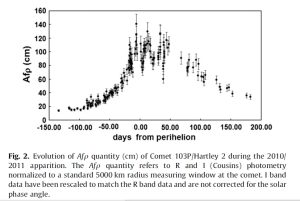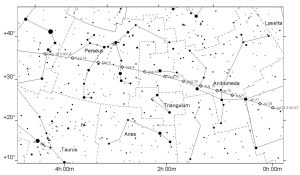2023 July 9
Comet 103P/Hartley Observing Campaign
103P/Hartley is a Jupiter family periodic comet which was discovered on 1986 March 15.59 by Malcolm Hartley using the 1.2-m UK Schmidt at Siding Spring, Australia. It was around 17th magnitude at discovery and showed a coma. It was visited by the EPOXI Spacecraft in 2010 and it has a peanut-shaped nucleus measuring around 2 km end-to-end with a tumbling rotation period of around 18 hours. The comet has an orbital period of just less than 6.5 years and it orbits between the paths of Mars and Jupiter.

The Italian CARA group of amateur observers contributed to ground-based monitoring of this comet in 2010 and helped to produce this lightcurve. The comet has a very strange tumbling rotation and that, combined with its peanut shape, leads to very peculiar changes in brightness, with a fast rises and fades, a confused, variable maximum and fast small brightenings [Icarus 222 (2013) 786-798]. The comet’s next perihelion is due this coming October and Giannantonio Milani of CARA has asked us to coordinate observations from BAA comet observers in order to help compile a detailed activity curve for this apparition.
Full details of this programme are being developed and will appear here shortly but, in summary, the programme is based on Afrho photometry and imaging. We will need images that conform to the following:
- Taken with a telescope using a CCD/CMOS sensor with linear response and a red photometric filter (R Cousins or Bessel or Sloan r’). A possible alternative could be an R colour filter from an RGB filter set with a passband between 600 and 700 nm although this is not ideal.
- An instrumental image scale around 1″-2″/pixel is ideal (or lower with very good seeing), but images can be accepted at an image scale up to 3-4″/pixel or so, specially around perihelion and when the comet is closer to Earth.
- Take a long image sequence of subs with exposures that freeze the proper motion of the comet within a pixel. The more images you take the better. A sequence lasting for 30-60 minutes could be a reference point. Note that a small outburst could randomly appear so a long sequence could be useful to detect these events too.
- Images need to be properly corrected with high-quality darks and flats. Do not apply any synthetic flats. Only sky flats or flats from a good uniform screen can be accepted. The master dark and flat must be averaged from a relatively long sequence in order to minimise noise. (At least 10 images but more is better).
- Two final images are stacked: one aligned on the stars and one on the comet’s motion. The average should be used or the sigma average if some stars are close to the comet. Ideally save the resulting FITS files in floating point format.
- Images will be measured with the Winafrho software and the Afrho data will be entered in the CARA database.
This is a good project if you have access to remote telescopes at dark sites. Some European observers have already joined and everyone interested in this project is welcome. Please contact me in the first instance and I will register your interest. This is a very interesting object and the goal is to achieve a good scientific result whilst having a good time in monitoring the comet.
The comet is currently a 17th magnitude morning object moving through Pegasus. It is well placed for us over the late summer and into the autumn. I imaged it in bright moonlight on the morning of July 7 and it was around magnitude 17.7. You can get an ephemeris from the MPC or JPL Horizons but note that the MPC predicted magnitude is currently far too bright.


Further reading
https://cometography.com/pcomets/103p.html
https://solarsystem.nasa.gov/asteroids-comets-and-meteors/comets/103p-hartley-hartley-2/in-depth/
| The British Astronomical Association supports amateur astronomers around the UK and the rest of the world. Find out more about the BAA or join us. |
